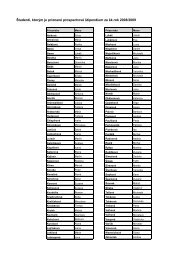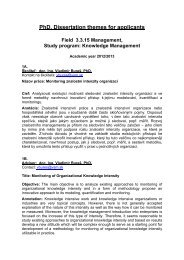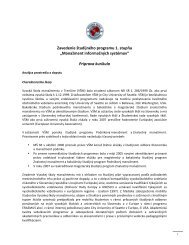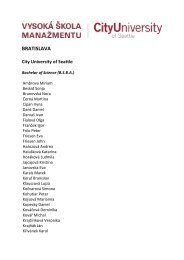American vs. Japanese Management 1 American vs. Japanese ...
American vs. Japanese Management 1 American vs. Japanese ...
American vs. Japanese Management 1 American vs. Japanese ...
You also want an ePaper? Increase the reach of your titles
YUMPU automatically turns print PDFs into web optimized ePapers that Google loves.
<strong>American</strong> <strong>vs</strong>. <strong>Japanese</strong> <strong>Management</strong> 1<br />
<strong>American</strong> <strong>vs</strong>. <strong>Japanese</strong> <strong>Management</strong> Style: Which One Yields Success<br />
Martina Bernhauerova<br />
martina.bernhauerova@<strong>vs</strong>m-student.sk<br />
MG 201 Introduction to Functions of <strong>Management</strong><br />
James Caldwell, J.D.<br />
Research Paper<br />
March 8, 2013
<strong>American</strong> <strong>vs</strong>. <strong>Japanese</strong> <strong>Management</strong> 2<br />
1.0 Introduction and Thesis Statement<br />
A company without a good management is doomed to extinction. That is why it is<br />
extremely important to choose the right management style that would not only prevent such<br />
dreadful fate, but would also bring a desired success to a company. The two mostly discussed<br />
styles that compete against each other in terms of which one is more successful are the<br />
<strong>American</strong> and <strong>Japanese</strong> management styles. Both styles are quite different, and the frequent<br />
debate that takes place when comparing these two involves a question, about which one<br />
works better and, therefore, should be implemented in companies. When the economy in the<br />
USA in the 1970s worsened, the <strong>Japanese</strong> economy sustained a fairly high growth rate during<br />
the same time (Uddin, 2011). The reason behind this could be that <strong>Japanese</strong> companies were<br />
managed in a better way than the <strong>American</strong> ones. Furthermore, <strong>Japanese</strong> factories have been<br />
considered to be using the best management style with high standards for quality while<br />
having the most advanced technology (Zaman & Unsal, 2000). On the other hand, <strong>American</strong><br />
companies have been very successful in the market as well. According to the World<br />
<strong>Management</strong> Survey, <strong>American</strong> companies seem to be excellent in their management styles<br />
because they are able to survive for a long time; they make more profit, and they also grow<br />
faster than companies in other countries (Bloom, Homkes, Sadun, & Reenen, 2011). Many<br />
people, though, still think that <strong>American</strong> companies should learn from the <strong>Japanese</strong> when it<br />
comes to management because they believe that <strong>Japanese</strong> management is more efficient.<br />
However, even though the <strong>Japanese</strong> management style does seem to hold a key to<br />
running a successful company, it also has its own weaknesses that might not ensure<br />
success at all without implementing a few practices from the <strong>American</strong> management<br />
first.
<strong>American</strong> <strong>vs</strong>. <strong>Japanese</strong> <strong>Management</strong> 3<br />
2.0 Synthesis of Information, Comparing & Contrasting Authors’ Views<br />
2.1 <strong>Japanese</strong> and <strong>American</strong> Corporate Social Responsibility from Richard E.<br />
Wokutch’s Point of View<br />
According to an associate management professor from the Pamplin College of<br />
Business in Virginia, Richard Wokutch (1990), the corporate social responsibility (CSR) in<br />
<strong>Japanese</strong> companies is far superior to the <strong>American</strong> one. Primarily, <strong>Japanese</strong> CSR can pose as<br />
a great example when it comes to the job security and health areas. Furthermore, <strong>Japanese</strong><br />
companies are very careful about the living environment because the <strong>Japanese</strong> have always<br />
been very reverencing towards the nature, mostly because of their religion. On the other<br />
hand, the <strong>American</strong> companies’ CSR demands are not being met adequately. When it comes<br />
to the job security and health, <strong>American</strong> companies are not at the same level as the <strong>Japanese</strong><br />
ones because the social norms in America differ from those in Japan. However, Wokutch also<br />
states that some of the CSR dimensions handled in America are actually far better, and the<br />
<strong>Japanese</strong> can learn quite a lot from them. Moreover, implementing <strong>Japanese</strong> approaches to<br />
CSR might not be too good because there is a difference between the emphasis on individual<br />
rights in America and Japan as well as the social environment in general. Unfortunately, the<br />
author does not mention any concrete dimensions that are handled better in America though.<br />
2.2 <strong>Japanese</strong> and <strong>American</strong> Corporate Social Responsibility from Dominique<br />
Drausnick Mals’ Point of View<br />
Dominique D. Mals (2012) from the Philosophy faculty at Westfälischen Wilhelms-<br />
Universität in Münster wrote a doctoral thesis about Japan being the leader in corporate social<br />
responsibility in the 21st century. According to Mals‘ research, <strong>Japanese</strong> organizations follow<br />
the beliefs that an individual should be "contributing to the society as a whole." On the other<br />
hand, <strong>American</strong> companies are focused more on satisfying themselves first and only then<br />
comes the society. These findings might suggest that <strong>American</strong> companies could learn some
<strong>American</strong> <strong>vs</strong>. <strong>Japanese</strong> <strong>Management</strong> 4<br />
of the <strong>Japanese</strong> approaches to CSR. However, Mals does not mention whether the <strong>Japanese</strong><br />
CSR approaches should be adapted into <strong>American</strong> companies.<br />
2.3 Comparison & Contrast of Viewpoints on <strong>Japanese</strong> and <strong>American</strong> Corporate<br />
Social Responsibility<br />
Richard Wokutch and Dominique Mals discussed the differences between approaches<br />
of corporate social responsibility in Japan and America. While Wokutch (1990) sees <strong>Japanese</strong><br />
CSR as superior to that of <strong>American</strong> companies, Mals (2012) does not belaud either one, or<br />
another. Mals simply demonstrates the biggest difference, which is the varying perception of<br />
what is more important for <strong>Japanese</strong> and <strong>American</strong> companies. According to Mals, in terms<br />
of CSR, <strong>Japanese</strong> organizations emphasize the importance of satisfying the society as a whole<br />
whereas <strong>American</strong> companies usually focus more on their own interests before looking at the<br />
society as a whole. However, even though Mals displays <strong>Japanese</strong> companies as an excellent<br />
example of CSR approaches, Wokutch believes that they do not excel in all dimensions of<br />
CSR. On the contrary, he states that there are many things that the <strong>Japanese</strong> could learn from<br />
the <strong>American</strong> approaches to CSR instead. What is more, although Mals might suggest that<br />
<strong>American</strong> organizations could implement some of the <strong>Japanese</strong> approaches to CSR, Wokutch<br />
demonstrates that these approaches will not be suitable for America due to differences<br />
between individual rights and social environment in Japan and America.<br />
2.4 Employees and Job Responsibilities in Japan and America: Takeshi Ohsawa’s<br />
View<br />
Takeshi Ohsawa (2010) from Human Resource Research Institute in Tokyo discusses<br />
the differences between <strong>American</strong> and <strong>Japanese</strong> management styles in terms of employees –<br />
the importance of employees as individuals, their loyalty towards a company, hiring and layoffs,<br />
and job responsibilities.<br />
According to Ohsawa (2010), in <strong>Japanese</strong> companies, people are a lot more important
<strong>American</strong> <strong>vs</strong>. <strong>Japanese</strong> <strong>Management</strong> 5<br />
than money or anything else. Managers and their employees can be viewed as a big family<br />
where each of them takes care of another. He compares the perceptions of a minimum unit<br />
within a company in Japan and America. He explains that within a <strong>Japanese</strong> company, the<br />
minimum unit is an individual while in an <strong>American</strong> corporation, the minimum unit is<br />
represented by a job. In other words, <strong>American</strong> employers focus on preparing the right job<br />
descriptions first, and then they try to find the right person with the right skills and abilities to<br />
meet the requirements needed for a successful performance of that job. Contrariwise,<br />
<strong>Japanese</strong> employers believe that each person has his/her own skills that will show what kind<br />
of job is suitable for that particular person, so there is no need to advertise the job<br />
descriptions beforehand - employers will just assign the right jobs to the new employees after<br />
learning about their abilities.<br />
Another interesting difference between <strong>American</strong> and <strong>Japanese</strong> management lies<br />
within the loyalty of employees towards a company. Since <strong>Japanese</strong> managers and their<br />
employees act like a big family, Ohsawa (2010) emphasizes that <strong>Japanese</strong> employees feel a<br />
great loyalty towards a company they work for. Even the contracts are based on trust between<br />
employers and their employees while in America, the contracts are based on concrete job<br />
descriptions only. Moreover, the great loyalty of <strong>Japanese</strong> workers also accrues from the fact<br />
that <strong>Japanese</strong> companies guarantee their employees a very good job security until they reach<br />
the age of 60 years whereas most of the <strong>American</strong> companies do not guarantee anything<br />
when it comes to a job security. Furthermore, while lay-offs are very often and absolutely<br />
common in America, in Japan, such actions are highly unacceptable in the society. Lay-offs<br />
in Japan occur only if an emergency comes up, such as bad employee’s discipline or<br />
bankruptcy.<br />
Ohsawa (2010) further demonstrates two more differences between <strong>American</strong> and<br />
<strong>Japanese</strong> management styles – hiring and responsibilities for group projects. When hiring a
<strong>American</strong> <strong>vs</strong>. <strong>Japanese</strong> <strong>Management</strong> 6<br />
new employee, <strong>Japanese</strong> companies look for someone who is cheerful, active, eager, and<br />
willing to devote himself/herself to the company, so they often do not hire employees based<br />
on their skills and knowledge. On the contrary, <strong>American</strong> companies specifically hire only<br />
those who are suitable for the particular job based on their abilities and proper education.<br />
Secondly, the responsibility for a project in <strong>Japanese</strong> companies is given to a whole team than<br />
just to one person like it is in <strong>American</strong> companies, where a team leader is usually the only<br />
one responsible for the project.<br />
2.5 Employees and Job Responsibilities in Japan and America: A Viewpoint of<br />
Pisal Yooyanyong and Nuttawuth Muenjohn<br />
Yooyanyong and Muenjohn (2010) also state that managers in <strong>Japanese</strong> organizations<br />
are responsible for their employees, and that they care for them. The managers emphasize the<br />
importance of good relationships with their subordinates because it seems to ensure good<br />
work performances and better deals. Even though <strong>Japanese</strong> managers prefer and support<br />
harmony and equity between team members, they also support criticizing among themselves.<br />
What is more, all compliments or criticism are directed to the whole team. On the contrary,<br />
<strong>American</strong>s do not use direct criticizing, and they pay almost none attention to a group<br />
harmony. All punishments or rewards in <strong>American</strong> corporations depend on individual<br />
performances of employees. The authors, however, do not illustrate the differences between<br />
<strong>Japanese</strong> and <strong>American</strong> management styles when it comes to employees’ loyalty to a<br />
company, hiring, or lay-offs.<br />
2.6 Employees and Job Responsibilities in Japan and America: Robert V.<br />
Anderson’s View<br />
Robert Anderson (2009) from Institute of Certified Professional Managers discusses<br />
different approaches to employees and their job responsibilities in America and Japan as well.<br />
According to him, <strong>Japanese</strong> emphasize a life-time employment, and the managers are
<strong>American</strong> <strong>vs</strong>. <strong>Japanese</strong> <strong>Management</strong> 7<br />
responsible for ensuring a harmony among team members who then contribute to achieving<br />
their company’s goals more effectively. Anderson also says that <strong>Japanese</strong> managers believe<br />
that an employee who stands out among the others should be somehow grounded whereas<br />
<strong>American</strong> managers believe that employees who stick out should probably be acknowledged<br />
and promoted.<br />
Anderson (2009) further demonstrates how the job responsibilities of employees in<br />
<strong>Japanese</strong> companies are perceived. He explains that <strong>Japanese</strong> have a special word for<br />
“motivating” others – “ganbare” – which is a rather assertive expression, usually resulting in<br />
employees pushing themselves too hard in order to succeed. Another thing demonstrated by<br />
Anderson is that <strong>Japanese</strong> companies rotate their managers every two or three years in order<br />
to make them experience various kinds of jobs. Even though the managers have the<br />
opportunity to learn about other departments of the company, the learning is limited by the<br />
small amount of time spent in each department.<br />
On the basis of a life-time employment in Japan, the management there expects<br />
employees to work long hours. Anderson (2009) says that employees spend only a little time<br />
outside the company, and if they are not found in their offices late in the evenings, managers<br />
transfer them to some dismissible jobs. Because of the fact that <strong>Japanese</strong> employees have to<br />
be loyal to one company, they cannot search for a new job in another corporation. Therefore,<br />
they have no choice, but to deal with the meaningful job they were transferred to. The author<br />
does not describe the <strong>American</strong> working hours though.<br />
As far as lay-offs are concerned, Anderson states that when <strong>Japanese</strong> organizations<br />
need to decrease their costs, they usually cut overtimes, transfer their employees, or offer<br />
their senior employees an early retirement. On the other hand, <strong>American</strong> companies always<br />
try to keep the profit high for managers, and that is when they start laying off their employees<br />
in order to maintain those high profits.
<strong>American</strong> <strong>vs</strong>. <strong>Japanese</strong> <strong>Management</strong> 8<br />
2.7 Comparison & Contrast of Viewpoints on Employees and Job Responsibilities in<br />
Japan and America<br />
Authors Takeshi Ohsawa (2010), Pisal Yooyanyong, Nuttawuth Muenjohn (2010),<br />
and Robert V. Anderson (2009) explore various differences regarding employees and their<br />
job responsibilities in <strong>American</strong> and <strong>Japanese</strong> corporations. All four authors agree that<br />
<strong>Japanese</strong> management supports harmony within the organizations where people are more<br />
important than money or jobs. Ohsawa describes <strong>Japanese</strong> management regarding employees<br />
and their job responsibilities in more details, including the reasons behind the great loyalty to<br />
one company – contracts based on trust, job security until age of 60 years, etc. He<br />
successfully compares these practices to those of <strong>American</strong> companies. Yooyanyong and<br />
Muenjohn, on the other hand, give more details mostly only about the different ways of<br />
expressing and directing criticism/punishments and compliments/rewards in Japan, where the<br />
whole team is being considered, and America, where the evaluation is delivered individually.<br />
Anderson, as the only one among all four authors, points out the long work hours that are<br />
expected from <strong>Japanese</strong> workers. Moreover, he successfully argues that job rotation every<br />
two or three years within <strong>Japanese</strong> companies is not always a good thing because of the little<br />
time spent in each department. Both Anderson and Ohsawa show the different perceptions of<br />
lay-offs in <strong>American</strong> and <strong>Japanese</strong> corporations. To sum up, all authors basically describe the<br />
main points in different management approaches in America and Japan; however, Anderson<br />
also points out a few negative aspects of <strong>Japanese</strong> management style that can pose as its main<br />
weaknesses, which somehow contradicts the generally good perceptions of <strong>Japanese</strong><br />
management.<br />
2.8 Decision Making Process in <strong>Japanese</strong> Companies: Viewpoint of Kazue<br />
Okamoto and Stephen Teo<br />
Kazue Okamoto from the University of New South Wales and Stephen Teo from the
<strong>American</strong> <strong>vs</strong>. <strong>Japanese</strong> <strong>Management</strong> 9<br />
University of Western Sydney (2009) describe the <strong>Japanese</strong> style of making decisions in a<br />
company. According to them, the decision making process in <strong>Japanese</strong> corporations consists<br />
of two processes – formal and informal. The first one that takes place is the informal process<br />
called “Nemawashi.” The authors explain that “Nemawashi” is being done among all<br />
employees in order to achieve a consensus. Then, the formal process can start by holding<br />
actual meetings. With such methods, the decision making process seems to bring even better<br />
results because of participation of all employees that involves many different points of view.<br />
The authors, however, do not compare <strong>Japanese</strong> style of decision making process to that used<br />
in America.<br />
2.9 Decision Making Process in <strong>Japanese</strong> Companies: Dinesh P. Chapagain’s View<br />
Professor Dinesh P. Chapagain from Nepal (1998), who is involved with National<br />
Productivity and Economic Development Centre, also describes <strong>Japanese</strong> decision making<br />
process. He explores this process in a little bit more details. Firstly, he explains the <strong>Japanese</strong><br />
“Ringi System” as a part of the overall decision making. According to him, this system is<br />
very helpful because thanks to it, the implementation of various recommendations and<br />
policies. The reason behind this is that the approval and opinions of people involved has<br />
already been discussed during this process. However, Chapagain does not explain the details<br />
of the “Ringi System.” On the other hand, he describes other aspects of <strong>Japanese</strong> decision<br />
making process. According to him, the <strong>Japanese</strong> have different communication methods<br />
which precede the good decision making. Firstly, the <strong>Japanese</strong> hold regular meetings of all<br />
manager levels and other employees every morning. Even their offices’ layouts are designed<br />
in a way that ensures a good and easy communication between employees and their managers<br />
– all employees work with their managers.<br />
Secondly, Chapagain mentions the “Nemabashi” process which means an unofficial<br />
leaking of information to those who are involved. However, the name of this process he used
<strong>American</strong> <strong>vs</strong>. <strong>Japanese</strong> <strong>Management</strong> 10<br />
is wrong because it is called “Nemawashi,” not “Nemabashi.” Another communication<br />
method is called “Nomanication” which means exchanging information while eating in<br />
restaurants or bars after work. The last important communication method that contributes to a<br />
good decision making process is the so-called “Horenso” reporting system. It is an<br />
abbreviation from three parts of this system – “Hokoku, Renraku, and Sodan.” Chapagain,<br />
however, does not provide the right <strong>Japanese</strong> terms for these three parts since the terms<br />
should be as follows: Houkoku, Renraku, and Soudan. Houkoku stands for report that should<br />
be comprehensive; Renraku means to contact, and Soudan stands for consultation or<br />
discussion (Nihongodict, 2009). Overall, Dinesh Chapagain successfully explains the general<br />
methods of decision making process in <strong>Japanese</strong> companies, but he misspells the technical<br />
<strong>Japanese</strong> terms involved in this process. Furthermore, the author does not provide any<br />
comparison of the <strong>Japanese</strong> way of making decisions and the <strong>American</strong> one.<br />
2.10 Decision Making Process in <strong>Japanese</strong> Companies: Robert Anderson’s View<br />
Aside from the explaining the perception differences between <strong>Japanese</strong> and <strong>American</strong><br />
management styles that have already been mentioned in this research paper earlier, Robert<br />
Anderson (2009) points out the different methods of decision making as well. He states that<br />
<strong>American</strong> corporations tend to make fast decisions in order to achieve immediate results. Due<br />
to this, <strong>American</strong> managers are usually the only ones making the decisions which are then<br />
communicated to subordinates. In Japan, on the other hand, companies use two methods for<br />
making decisions. The first one involves a proposal – “Ringisho” – that makes its way from<br />
the lower levels of the management upward, seeking an approval – “Kessai.” The second<br />
method of decision making process is “Nemawashi.” Here, there are two approaches that take<br />
place: informal meeting or social gathering – “Kondankai” – and formal meetings – “Kaigi”<br />
(Nihongodict, 2009). Anderson also demonstrates the advantages and disadvantages of the<br />
<strong>Japanese</strong> decision making process. The main advantage is the bigger participation where all
<strong>American</strong> <strong>vs</strong>. <strong>Japanese</strong> <strong>Management</strong> 11<br />
employees involved can contribute with their opinions and points of view. This, however, can<br />
be also viewed as a disadvantage because there are too many people participating and lots of<br />
meetings. Moreover, due to the high number of participants, the proposals and decisions are<br />
made slowly.<br />
2.11 Comparison & Contrast of Viewpoints on Decision Making Process in<br />
<strong>Japanese</strong> Companies<br />
Kazue Okamoto, Stephen Teo (2009), Dinesh Chapagain (1998), and Robert<br />
Anderson (2009) describe the <strong>Japanese</strong> style of decision making process. The most detailed<br />
description is made by Anderson who not only explains the whole <strong>Japanese</strong> decision making<br />
process, including the “Ringi” and “Nemawashi” systems, but he also compares this process<br />
to the one used in <strong>American</strong> corporations. Moreover, he points out the main advantage and<br />
disadvantage of <strong>Japanese</strong> decision making process – more various contributions to decision<br />
making <strong>vs</strong>. slow proposals and decisions. Kazue Okamoto and Stephen Teo lack information<br />
about the “Ringi System,” and they do not provide any comparison to the <strong>American</strong> decision<br />
making process. What is more, since they do not include the “Ringi System,” they wrongly<br />
assume that informal and formal methods of decision making process are two different things<br />
when, in fact, both are the parts of the “Nemawashi System.” Dinesh Chapagain provides a<br />
very weak explanation of the “Ringi System” – he does not describe how it works. Moreover,<br />
he misspells the technical <strong>Japanese</strong> terms used in the decision making process, and he does<br />
not show any comparison to <strong>American</strong> decision making process. On the other hand, he<br />
provides additional communication background in <strong>Japanese</strong> companies that lead to a better<br />
decision making process, including the “Nomanication” and “Horenso” reporting system.<br />
3.0 Further Thoughts on <strong>Japanese</strong> <strong>vs</strong>. <strong>American</strong> <strong>Management</strong> Style: Which One Is<br />
Supposed to Be Better<br />
3.1 <strong>Japanese</strong> <strong>Management</strong>: A Better But Not So Flawless Way to Success
<strong>American</strong> <strong>vs</strong>. <strong>Japanese</strong> <strong>Management</strong> 12<br />
<strong>Japanese</strong> management style probably holds a more important key for a successful<br />
company than the <strong>American</strong> one. However, there are some approaches in the <strong>Japanese</strong><br />
management that have their own flaws which could be fixed by learning and adapting some<br />
approaches from <strong>American</strong> companies.<br />
3.2 Arguments in Favor of <strong>Japanese</strong> <strong>Management</strong><br />
Firstly, <strong>Japanese</strong> <strong>Management</strong> seems to be far superior to the <strong>American</strong> one when it<br />
comes to the corporate social responsibility - CSR (Wokutch, 1990, & Mals, 2012). <strong>Japanese</strong><br />
ensure a better job security; they are more concerned about health, and they strongly care for<br />
the living environment. Furthermore, the <strong>Japanese</strong> always satisfy the society as a whole.<br />
Secondly, <strong>Japanese</strong> companies practice better approaches towards their employees.<br />
For <strong>Japanese</strong> managers, people and harmony among employees are more valuable than<br />
anything else (Ohsawa, 2010; Yooyanyong & Muenjohn, 2010; & Anderson, 2009). In Japan,<br />
the employment is a life-time matter where each employee is loyal to only one company. This<br />
is a very good aspect because it means a great loyalty from the employee’s side. A project is<br />
always taken care of by a whole group, team, where all members are responsible for the<br />
project equally. All compliments, rewards, or punishments and criticism are directed to the<br />
whole team, not only the team leader. Also, when it comes to managing their employees, the<br />
<strong>Japanese</strong> have an excellent approach to make the managers learn about the company they<br />
work for as much as possible. The great idea bears the name “job rotation” where <strong>Japanese</strong><br />
managers are transferred every two or three years to different departments within a company<br />
to enhance their knowledge and experience.<br />
Lastly, <strong>Japanese</strong> decision making process certainly appears to be the best way how to<br />
make decisions properly. Thanks to the two methods used for <strong>Japanese</strong> decision making<br />
process – the “Ringi” and “Nemawashi” systems - the proposal of decisions is discussed<br />
among all employees and at lower levels of management, and only then it is pushed upward
<strong>American</strong> <strong>vs</strong>. <strong>Japanese</strong> <strong>Management</strong> 13<br />
(Okamoto & Teo, 2009; Chapagain, 1998, & Anderson, 2009). This way, the decisions are<br />
made more carefully and more points of view are involved. Therefore, the outcomes are<br />
probably better and more successful.<br />
3.3 Arguments against <strong>Japanese</strong> <strong>Management</strong><br />
Even though <strong>Japanese</strong> management is said to excel in the corporate social<br />
responsibility approaches, not all dimensions of the <strong>Japanese</strong> CSR approaches are superior<br />
because there are still some of them that are handled in America better (Wokutch, 1990).<br />
Moreover, <strong>American</strong>s and <strong>Japanese</strong> have different emphasis on the social environment and<br />
individual rights; therefore, it is hard to tell which CSR approaches are better for a company’s<br />
success.<br />
Although <strong>Japanese</strong> companies practice better approaches towards their employees, at<br />
the same time, the preferences in hiring workers and a different perception of job descriptions<br />
are not so good (Ohsawa, 2010; Yooyanyong & Muenjohn, 2010; & Anderson, 2009). A<br />
great loyalty from the employee’s side towards one company is very good. However, if, for<br />
some reasons, an employee is transferred to a meaningful job because of bad performance,<br />
he/she cannot apply for a job in a different company due to the “life-time employment.”<br />
When it comes to responsibilities for a project, it might be good that the whole team is<br />
responsible for the project, but it also means that even those, who are not at fault when<br />
something goes wrong, will be criticized and punished. Regarding <strong>Japanese</strong> managers, they<br />
are supposed to enhance their knowledge and experience by being placed in different<br />
departments within the company they work for every two or three years. However, two or<br />
three years is a small amount of time, during which managers cannot really become too much<br />
of experts on the different departments’ practices.<br />
Even though the <strong>Japanese</strong> style of decision making process might be better and more<br />
successful because decisions are made more carefully and more points of view are involved,
<strong>American</strong> <strong>vs</strong>. <strong>Japanese</strong> <strong>Management</strong> 14<br />
this process is much more time-consuming and slow than the <strong>American</strong> one where the<br />
decisions are made fairly quickly.<br />
3.4 Weaknesses of the Arguments against <strong>Japanese</strong> <strong>Management</strong><br />
As far as the corporate social responsibility is concerned, the arguments against<br />
<strong>Japanese</strong> approaches are quite feeble because the authors discussing this issue have not<br />
provided any further information about CSR dimensions that are better handled in America.<br />
Therefore, it is difficult and almost impossible to identify whether there is really something<br />
that <strong>Japanese</strong> should learn from <strong>American</strong>s in this matter.<br />
When it comes to employees and their job responsibilities in Japan and America, the<br />
statement that <strong>American</strong> team leaders are the only ones responsible for the whole team and<br />
the project they work on is not supported properly. In <strong>American</strong> corporations, each employee<br />
is responsible for his/her job; the team leader is not the only taking responsibility for either<br />
success, or failure. Furthermore, when the project is a success, all team members profit from<br />
it, and when it is a failure, again, all team members suffer from it. Regarding the job rotation<br />
within <strong>Japanese</strong> companies, the statement whether two or three years is a small amount of<br />
time to become an expert is irrelevant. Some people learn quicker than others, so for them,<br />
such amount of time might be just right and sufficient in order to learn all the most important<br />
practices in different departments. They might not become experts, but they certainly learn<br />
more about other departments thanks to this than from sticking to their department only.<br />
As for the decision making process, in terms of identifying a more efficient way of<br />
making decisions, the <strong>Japanese</strong> are still better at this. Even though it might take more time,<br />
the fact that they come up with better decisions that are not hasty still remains.
<strong>American</strong> <strong>vs</strong>. <strong>Japanese</strong> <strong>Management</strong> 15<br />
4.0 Conclusion<br />
The main point of this research paper was to compare the <strong>Japanese</strong> and <strong>American</strong><br />
management styles and find out which of these styles has better assumes for managing a<br />
successful company. By comparing different views of various authors discussing main<br />
differences, such as the corporate social responsibility approaches, perceptions of employees<br />
and their job responsibilities, and methods of decision making process, it can be said that<br />
<strong>Japanese</strong> management presents a bigger chance of success. However, there are still some<br />
flaws in the <strong>Japanese</strong> style that makes this statement a little bit questionable. Still, even<br />
though <strong>Japanese</strong> can learn a few things from the <strong>American</strong> corporations, they do not have to<br />
learn as much as <strong>American</strong>s should learn from them. To conclude, <strong>Japanese</strong> companies are on<br />
this path much closer to the desired destination going under the name “success,” and when<br />
they adapt some of their missing practices from <strong>American</strong> corporations, they will certainly<br />
arrive to the goal straight away.
<strong>American</strong> <strong>vs</strong>. <strong>Japanese</strong> <strong>Management</strong> 16<br />
5.0 References<br />
Anderson, R. V. (2009, March/April). <strong>Japanese</strong> and <strong>American</strong> management: Contrast of<br />
styles. Retrieved February 5, 2013, from http://cob.jmu.edu/icpm/management_world<br />
/CMartMar09.pdf<br />
Bloom, N., Homkes, R., Sadun, R, & Reenen, J. V. (2011, June 13). Why <strong>American</strong><br />
management rules the world [blog post]. Retrieved February 1, 2013, from<br />
http://blogs.hbr.org /cs/2011/06/why_american_management_rules.html<br />
Chapagain, D. P. (1998). <strong>Japanese</strong> style management. Retrieved February 1, 2013, from<br />
http://www.dineshchapagain.com.np/admin/files/<strong>Japanese</strong>%20Style%20<strong>Management</strong>.<br />
pdf<br />
Houkoku. (2009). In Nihongodict <strong>Japanese</strong> online dictionary. Retrieved from http://www<br />
.nihongodict.com/s=houkoku<br />
Kondankai. (2009). In Nihongodict <strong>Japanese</strong> online dictionary. Retrieved from http://www<br />
.nihongodict.com/w/27720/kondankai/<br />
Mals, D. D. (2012). Japan: Leader in CSR for the 21 st century. Retrieved March 2, 2013,<br />
from http://miami.uni-muenster.de/servlets/DerivateServlet/Derivate-6544/diss<br />
_drausnick.pdf<br />
Ohsawa, T. (2010, January 2). Introduction to characteristics of <strong>Japanese</strong> management style:<br />
For better understanding of cultural differences in comparing MBTI data of Japan<br />
with that of other countries. Retrieved February 1, 2013, from http://www.docstoc<br />
.com/docs/21041155/Introduction-to-Characteristics-of-<strong>Japanese</strong>-<strong>Management</strong>-Style-<br />
For<br />
Okamoto, K., & Teo, S. T. T. (2009). Forms of informal management controls in overseas<br />
<strong>Japanese</strong> companies: A qualitative study. Employment Relations Record, 9(1), 64-82.<br />
Retrieved from Business Source Complete database.
<strong>American</strong> <strong>vs</strong>. <strong>Japanese</strong> <strong>Management</strong> 17<br />
Renraku. (2009). In Nihongodict <strong>Japanese</strong> online dictionary. Retrieved from http://www<br />
.nihongodict.com/w/54159/renraku/<br />
Soudan. (2009). In Nihongodict <strong>Japanese</strong> online dictionary. Retrieved from http://www<br />
.nihongodict.com/s=soudan<br />
Uddin, M. J. (2011, July). Impact of <strong>Japanese</strong> management approaches on workers: Evidence<br />
from Brazil. Interdisciplinary Journal of Contemporary Research in Business, 3(3),<br />
443-450. Retrieved from Business Source Complete database.<br />
Wokutch, R. E. (1990, May). Corporate social responsibility <strong>Japanese</strong> style. The Executive,<br />
4(2), 56-74. Retrieved from Pamplin College of Business website: http://www<br />
.management.pamplin.vt.edu/directory/Articles/Wokutch7.pdf<br />
Yooyanyong, P, & Muenjohn, N. (2010). Leadership differences: Comparison between<br />
<strong>American</strong> and <strong>Japanese</strong> expatriate managers. Retrieved February 2, 2013, from<br />
http://jgxy.usx.edu.cn/DAOM/097_PisalYooyanyong.pdf<br />
Zaman, M. R., & Unsal, F. (2000, January). Comparative performance of <strong>American</strong>,<br />
European and <strong>Japanese</strong> automobile companies in the 1990s. <strong>American</strong> Business<br />
Review, 18(1), 115. Retrieved from Business Source Complete database.
















